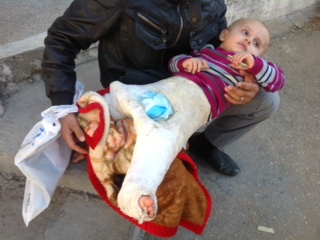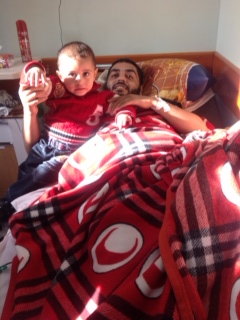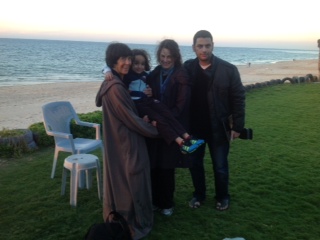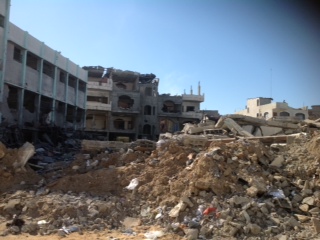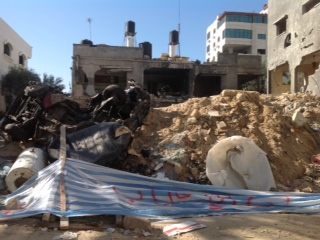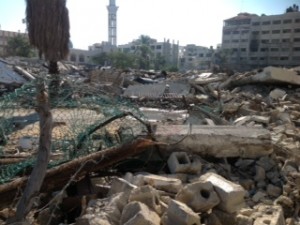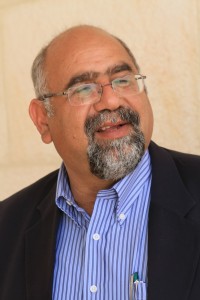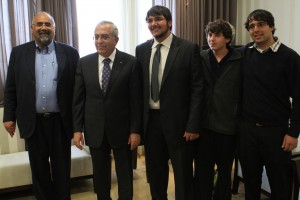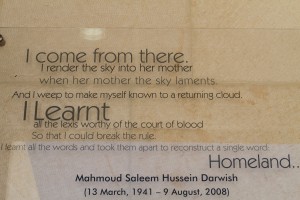(Gerri Haynes and Laura Hart, of Washington Physicians for Social Responsibility, have returned to Gaza, taking in medicine. Gerri will be sending back reports.)
At Al Awda Hospital, one of the physicians told us he has lost most of his hearing as a result of a bomb blast – the explosion destroying the car driving next to this doctor’s car. Al Awda is located in Jabalyia Refugee Camp – one of the most densely populated places on earth – and received bomb damage in several areas.
We also visited with a young man who was shot yesterday in the newly opened “no go” agricultural area near the border with Israel. This young man was with friends and
received a vessel-shattering wound to his groin. He crawled to his friends who then rushed him to the hospital (in private transportation). On arrival, he was in cardiac arrest and had nearly bled to death. Today, he was awake and stable enough to hold his little son.In the afternoon, we accompanied Dr. Mona Farrah of the Middle East Children’s Alliance (MECA) to a school run by the United Nations Relief and Works Agency (UNRWA). This school serves middle school boys and runs two shifts of 1,140 children per shift. During Pillar of Cloud, 300 families (2000 people) were housed in the school. Many schools housed people whose homes were deemed to be in the path of bombs, but 70 people were injured
– there was no safe place. Over and over, we hear that the leaflets dropped by Israel, warning of coming bombs created chaos because there were no assured safe places to go.MECA has installed water purification systems in 16 schools in Gaza. Because 95% of the water here is unsafe for drinking, the purification of water is a major concern. The isolation and imprisonment of Gaza has many serious public effects – including a sense that the world often forgets that 1.7 million people are living under conditions creating increasing public health crises.
Staff of the school voiced interest in developing pen pal relationships for their students with students in the United States. The resilience of the people continues.
(Gerri Haynes and Laura Hart, of Washington Physicians for Social Responsibility, have returned to Gaza, taking in medicine. Gerri will be sending back reports.)
Dr. Sarraj reviewed for us the history of Palestine since 1948. He has been involved in every phase of governmental and medical development for many years and provides council in each move toward peace. We spoke of the need for freedom for Gaza. The vote to accept Palestine as an observer state in the UN has created a window of hope.
Throughout Gaza, a sense of possibility is reported. We look forward to a day when the infrastructure of Gaza can be repaired instead of destroyed – when electricity is available continuously, when the water can be cleaned and the sewage safely treated. We look forward to a day when there are enough schools to house the children seeking education, when trade with the outside world can be fulsome, when fishing can be extended to the deep sea area.
The population of Gaza prizes education and wants to extend all phases of educational offerings – including advanced medical education and research. The possibility exists. Last Spring, I asked a friend in Gaza how long it had been since he turned on a faucet and took a drink of water. He paused and replied, “Never.” We look forward to the day when his response will be “Today.”
This evening, Ann Wright and a group from Code Pink visited the hotel where Laura and I are staying. I visited briefly with them and heard that when Pillar of Cloud started, they had rapidly gathered a group of more than twenty people to come to Gaza. They are observing and learning and will return to their countries to help others become more aware of the situation here.
Perhaps others will hear what we are hearing: the shelling in Pillar of Cloud created fires that were difficult to put out; agricultural areas were shelled and there is concern about what poisons future crops may contain; there is a group gathering water from rain puddles to see what chemicals are in the air; there is concern about what properties were used in the bombs dropped by Israel – did they contain Uranium 238 or some other permanently dangerous properties.
So while hope exists, the realities of war – the fatalities, the injuries to people and land, the ongoing sense of trauma – exist. We are constantly inspired by the courage of the people we meet.
(Gerri Haynes and Laura Hart, of Washington Physicians for Social Responsibility, have returned to Gaza, taking in medicine. Gerri will be sending back reports.)
One car holding two young men was targeted – they were both killed. The car now sits in the lot adjacent to their home and their mother is said to visit the car each day.
The death of 172 people and the injury of thousands left this community once again shocked and terrified – even though the truce holds, there is the feeling of extreme danger that the bombing could begin again at any time. We hear again and again, “To survive the war is a victory.”We have talked with many people about how they helped themselves and their children to cope during the bombing. Some people used their voices to make loud sounds, some people huddled together in rooms that seemed the strongest, and some people left their homes in areas that felt more at risk and went to relatives – only to have the areas of their relatives targeted. A teacher told us that one of the most intelligent children in her class returned to school after the truce and seemed unable to talk – holding himself and being isolated. This teacher is creative in helping her students cope with what they have experienced…psychodrama, drawing, verbal expression…but the constant threat of more attacks makes healing difficult.
Yesterday afternoon, we met with the Director from the Ministry of Health who is responsible for organizing international medical delegations. He spoke of the growing medical program in Gaza – they now have 164 candidates for advanced medical specialty training and are seeking host medical communities to offer short sabbatical training for some of their specialty physicians. In preparation for WPSR’s next medical delegation, he listed several medical specialties that would be most helpful for providing direct care and for teaching. Since movement in and out of Gaza is difficult, bringing physicians here to assist with patient diagnosis and care is needed.This afternoon, we will meet again with Dr. Sarraj, founder of the Gaza Community Mental Health Programme.
(THIS POST FROM GERRI WAS LOST SOMEWHERE BETWEEN PARIS AND SEATTLE. IT SHOULD HAVE BEEN THE FIRST IN THIS SERIES)
(Gerri Haynes and Laura Hart, of Washington Physicians for Social Responsibility, have returned to Gaza, taking in medicine. Gerri will be sending back reports.)
Laura Hart and I have planned this visit for several months. We thought we would visit our friends in Gaza for two days and then go to Bethlehem to see Zoughbi Zoughbi – then maybe go up to see another friend in Nablus. We received permission from Israeli security early in our travel plans – two months ahead of our planned day of entry! My husband, Bob, ordered medicines as requested by the Gaza Community Mental Health Programme with the money we had gathered since our last visit to Gaza in April of this year.
Our WPSR group has made five medical service trips to Gaza since 2009 and we thought a planning visit with our GCMHP hosts might help us make our next service trip – scheduled for April 2013 – more focused. We were ready to travel. It would be a quick visit.
Then came the Pillar of Cloud (or Defense – depending on how you read the words)…six people dead on the Israeli side, 172 people and many hundreds injured in Gaza – many buildings destroyed – the threat of another ground attack – then the truce. So here we are on a plane – we’ve traveled together many times and are good at providing each other with privacy and support – we are companionable travelers, hoping to offer some help or comfort to our friends in Gaza.
About one week ago, I sent out a notice to my email list that we were planning to make this trip and wondering if people would like to help us purchase more medicine. Five thousand dollars and many important good wishes came quickly to us! Some people designated medicines – some were happy to buy school supplies – so we’re traveling with three times as many medicines as we planned and one bag full of needed school supplies – an offering to the huge present need for help, sent with the love and commitment of so many friends.
Only freedom to move and trade will bring the independent ability to address the needs of the people of Gaza.
Laura and I will land in Paris, quickly change planes and fly on to Tel Aviv. We’ll have dinner with a dear friend in the airport, then spend the night at Neve Shalom (Place of Peace), run by Jewish and Palestinian Israelis. Wednesday morning, we hope to enter Gaza.
I’ll keep you posted.
(Gerri Haynes and Laura Hart, of Washington Physicians for Social Responsibility, have returned to Gaza, taking in medicine. Gerri will be sending back reports.)
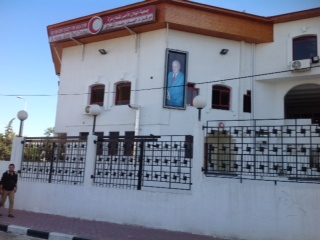
Palestinian red crescent society clinic where staff worked seven days without a break during the recent Israeli attacks.
It has been observed that children who experience the level of trauma and uncertainty of life in Gaza often disconnect emotionally from their parents and other adults. Trust in security is lost when there is a sense that no one can keep a child safe from harm. The staff of GCMHP is planning to develop and test a tool to evaluate this disconnection in children and to formulate a healing plan.
For the future of Gaza, there is some optimism. The truce seems to be holding and there is a promise of increasing freedom of movement. Increasing the boundaries for fishing and for working in the agricultural areas can result in some relief for the economy. At the same time, there is a general concern about the ever-present threat of war.
Today we met with many health care people. We had a brief meeting with the Palestinian Red Crescent Society staff who worked round-the-clock while Gaza was under attack from Israel this month. The nurses, housekeepers, physicians, technicians and security guard are meeting together to review their work and provide support to each other for the experience of working in war.
In a meeting with personnel of the Gaza Community Mental Health Care Programme clinic we again heard about the universal level of trauma experienced in Gaza. Staff members spoke of their plans to train health care workers to provide care in homes and noted the debriefing sessions they are holding for the Programme staff. As all the people of Gaza have experienced the continuous injury of trauma (from the reality of living in an open-air prison to the terror of bombs falling close to their homes), there is a comprehensive need for emotional and mental health care.
One gentleman we spoke with today told of his extended family gathering in his home for safety during the bombing. In the two hours prior to the signing of the truce, bombing was constant and very near his home. For those two hours, forty people crowded into a 9×12 foot kitchen area (the area furthest from the bombs).
Every person we speak with expresses hope for peace and greater freedom. With kindness, we are also hearing a wish for the people of Israel to live in peace and without fear of war.
(Gerri Haynes and Laura Hart, of Washington Physicians for Social Responsibility, have returned to Gaza, taking in medicine. Gerri will be sending back reports.)
On the way to Erez and the hoped-for crossing to Gaza… the night held little sleep – the roosters started crowing at 2 a.m., then I had a phone call from Kirkland at 4 a.m. (an invitation to our grandchildren’s for a Santa Claus event). The staff at Neve Shalom is always helpful and sent us off with a breakfast bag and coffee.We are now driving past Israeli towns north of the Gaza border. Fields of crops fill the spaces between towns – drip irrigation is used extensively here. We see no evidence of rocket damage from last week’s conflict.
Elias from Bethlehem is driving us to Erez. He says he has many Jewish friends – the people are not the problem, the troubles are between the governments. He says tourists stopped coming to Bethlehem during Ahmoud al Shab (Pillar of Cloud).
And now we are at Erez – our friends from Gaza await our call to let them know whether or not we are allowed to pass through the checkpoint.
More to follow…
IN GAZA:
The passage through into the Palestinian side was uneventful– many NGO personnel are making this journey and we were required to wait only a brief time on the Israeli side. Entering into Gaza through the Hamas checkpoint required much more time as we had medicines that required thorough screening.
Now we are in Gaza City. On the way to our hotel, we saw some of the results of last week’s attacks. A four-story government building is now rubble. The Prime Minister’s office building is no more.
We are seeing many friends from other trips and tonight we will have a meeting with Dr. Sarraj of the Gaza Community Mental Health Programme in his home. Our goal is to sort out ways that our next medical service delegation can be most helpful.
There is great sorrow here for the people who were killed or injured in Pillar of Cloud as well as a general sense of relief that this recent warring did not include a ground invasion. There is also a belief that the truce was signed prior to the intervention of the US Secretary of State. The ongoing trauma of war or threat of war is pervasive.
Stephen M. Walt is the Robert and Renée Belfer professor of international relations at Harvard University. This post originally appeared online at Foriegn Policy and is used with the permission of the author.
Back in 2002, a group of influential neoconservatives convinced President George W. Bush and Vice President Dick Cheney that it was a really smart idea to invade Iraq.
With help from AIPAC and other groups in the Israel lobby, and an assist from Israeli politicians like Ehud Barak, Shimon Peres, and Benjamin Netanyahu, the neocons and the Bush administration then persuaded the U.S. Congress to authorize the use of force by an overwhelming bipartisan majority. Most of the top figures in the Obama administration (including then-Senators Joseph Biden and Hillary Clinton) supported the war.
Given how that foolish adventure turned out (4,500 dead Americans, $1-2 trillion down the drain, etc.), you’d think the last thing the United States would be contemplating is another preventive war in the Middle East.
You’d think that the architects of that earlier debacle would have been as badly discredited as George Custer, Neville Chamberlain, or Charles Lindberg, and that only certifiable war-mongers would be paying attention to their strategic advice. And you’d certainly think that Congress would have learned its lesson, and would be subjecting calls for a new war to careful scrutiny and wide-ranging debate.
How wrong you’d be. Case in point: the recent letter that a bipartisan group of 44 senators recently sent President Obama, declaring that, “Iran must come into full cooperation with the IAEA and full compliance with all relevant United National Security Council resolutions, including verifiable suspension of nuclear enrichment.”
The senators also insist that the “absolute minimum steps that Iran must take immediately are shutting down of the Fordow facility, freezing enrichment above 5 percent, and shipping all uranium enriched above 5 percent out of the country. And if Iran does not capitulate to our demands, the senators urge Obama “to reevaluate the utility of further talks at this time and instead focus on significantly increasing the pressure on the Iranian government through sanctions and making clear that a credible military option exists” (my emphasis).
If you ever wondered why so few Americans have any respect for Congress, here’s part of your answer. (To be sure, disrespect for Congress is by now over-determined, given our representatives’ dysfunctional behavior on a wide range of issues. But still … ) As Glenn Greenwald notes, in this case those beating the drums of war include a number of prominent “liberal” Senators, including progressives like Ron Wyden and Jeff Merkley of Oregon. And as I pointed out earlier this week, the terms the senators are insisting upon are almost certainly a deal-breaker from Iran’s point of view.
I’m still convinced that the Obama administration understands war is foolish — you can go here if you’d like to watch a fuller presentation of my views on this topic — but as Robert Wright noted a few days ago, he is being boxed in by the pro-war faction — the usual alliance of Israel, AIPAC, the neocons, and a few Christian Zionists — and he isn’t getting any cover from the supine members of Congress. The result: Negotiations that go nowhere as a “drift” toward war continues.
So what can you do? As it happens, there is an online petition at the Credo/Working Assets website opposing war with Iran. It has garnered over 100,000 signatures so far, including mine. You can sign it yourself by clicking on this link and following the instructions. I’m not saying your signature will stop another foolish war all by itself, but it can’t hurt.
(Seattle activist Bert Sacks defied the draconian sanctions against Iraq, for which the U.S. government fined him $16,000. But he refused to pay despite years of government threats and court actions.)
I’ve decided to continue to reflect on what these past years working on the Iraq sanctions issue have meant to me. Was it worth it? What have I learned? How has it changed me?
As part of my personal reflections, I realize there are two factual areas which need further mention: they involve the U.S. Courts and the U.S. State Department.
In 1996, when I first began to understand what we were doing to the Iraqi people, I could not believe that it would be judged legal. I wanted to get into court to present the evidence and argue against the policy. Thanks to lawyers at the firm of Garvey Schubert Barer – especially to attorney Don Scaramastra – we began a law suit against the Office of Foreign Assets Control (OFAC), the federal agency which oversees U.S. sanctions.
The years of our law suit against OFAC have been a real-world education for me. After OFAC fined me $10,000 I replied to them with these words: “I want to explain here, as I would to any personal friends of mine, why I have done this ….” It was my initial effort to begin a dialogue with the people who fined me for going to Iraq to bring medicine.
From a biography of Mahatma Gandhi titled My Life is My Message by Narayan Desai, I recently came across this paragraph: “Those who are convinced that truth and justice is on their side seize every opportunity of entering into a dialogue with the opponent.
Those who use physical force do not comprehend the power of thoughts and disregard the efficacy and validity of the process of dialogue.”
I cannot think of a better comment on my initial efforts responding to the fine.
After 15 years of dealing with OFAC – including supplying them with over 100 pages of documentation showing what sanctions were doing – I have never had one word of response to my efforts to discuss the substance of what U.S. policy was doing. Perhaps I should not be too surprised. But I really expected more from our legal system.
In 2004 our law suit reached Judge James L. Robart in U.S. District Court. At the end of oral arguments he unexpectedly invited me to address the Court and, in part, I said this:
[I]f we have honored, accepted in some form either the Geneva Convention, the convention against genocide and the customary international law that we, I trust, should respect, then what prompted me in my trips to go to Iraq was the knowledge from the New England Journal of Medicine from 10 years ago, when I first discovered it, that 46,900 children in Iraq had died within the first eight months.
Now, I’ve been struggling for many years to find something that I could do that would help to be a responsible citizen of this country to stop this process which is clearly killing thousands of children every month.
If it is in fact correct that the customary international law that applies in this case, the rights of the children, the Geneva Convention, the Genocide Convention, cannot be brought in front of a domestic Court because the President [sic, and Congress] has standing to overrule those customary international laws, then that issue puts me, and I think all the other citizens of the country, in a quandary.
What can we do if we feel that some gross, terrible human rights violation is occurring under our government? And that to me is the central issue.
Judge Robart then replied to what I’d said:
Mr. Sacks, you’re right in that the issues that are before the Court many times involve legal principles that seem very separated from the facts that are also before the Court.
The Judge is saying that the undisputed facts of the case – that economic sanctions had caused the deaths of 100,000s of Iraqi children – were separate from “the legal principles” before the Court. And that in this case the legal principles render the facts irrelevant.
In short, if Congress chooses to kill Iraqi children and the Executive implements the policy – as long as they cross all the t’s and dot all the i’s – the legal principles trump any customary international law. And this includes the international prohibition of genocide.
That should be a shock to all of us who believe in the importance of the rule of law.
(Just to be clear: Judge Robart did not weigh the facts and then rule that U.S. policy on Iraq was not genocide; he did not rule that if U.S. policy on Iraq did constitute genocide it would nevertheless be legal; he did rule that Congress had prohibited anyone from raising a charge of genocide in federal court – except for the U.S. itself.)
It was not until after our appeal to the Ninth Circuit Court, when we were petitioning the U.S. Supreme Court to take up our case, that I learned of the legal concept jus cogens. Also called peremptory norms, they designate “a fundamental principle of international law which is accepted by the international community of states as a norm from which no derogation is ever permitted.”
Genocide is generally considered such a norm. My point is not to claim that U.S. policy on Iraq was genocide – legal scholars do debate that – but rather that in the suit we brought, the Court held U.S. law can override any international norm, even genocide!
(Of course the most egregious case is that the Courts refuse to rule on “the supreme international crime, initiating a war of aggression” – to quote Justice Jackson at Nuremberg – instead asserting it is a “political question” whether a war is a crime.)
After the Supreme Court refused to hear our case – including the jus cogens argument – I imagined my struggles on the legal front were over. But in March 2010, I was served notice that the Department of Justice was suing me to collect the fine which I’d refused to pay all these years. By this time, I had become fully convinced that the economic sanctions on Iraq – for the purpose of overthrowing the President of Iraq (as senior U.S. officials have clearly stated) by means of inflicting massive suffering on the Iraqi people – came to constitute the crime of international terrorism … according to our own laws.
My Declaration to the Court provides evidence and makes this argument very clearly.
U.S. District Judge Richard A. Jones presided over this case. He eventually dismissed the suit to collect the fine as being untimely. While that was a relief of sorts, I would have wished for him to hear the arguments I made in the material I provided the Court.
Even if he had already decided to rule on the narrow (and essentially technical) grounds of Statue of Limitations, was it not important to publicly listen to the facts that the U.S. had engaged in a massive crime of terrorism against the Iraqis? All the more so because the U.S. is now engaged in an essentially endless war against (yes, that’s right) terrorists.
I can only wonder if Judge Jones didn’t allow this evidence because of its relevance.
The education I’ve received from pursuing the matter in U.S. courts is that – whatever sympathy the judges may have with the issues I raised – they were unwilling to allow in their courts any serious legal challenge to a major official policy of the United States.
(For those who are new to this blog, earlier posts and pull-down menus contain much supporting evidence, many more details, and links to original sources where possible.)
I can see now that my reflections on the U.S. State Department will have to wait for next month. I also realize that I have more things of a general nature I want to reflect on.
For example, in my March posting I wrote about “activism as a tool for coming to truth.” My activism in the U.S. court system has certainly brought me closer to a truth about how our legal system operates when dealing with a major foreign-policy issue.
And that raises a related question: Do I really want to know truths like this?!
The answer to that question, I would say, depends on what I call my world-view “working hypothesis.” Others might call it their “faith” in how the world actually is. (Yes it’s true, I studied science and engineering in college, not theology.)
By a “working hypothesis” I mean, what do I suspect is true: Do I believe that knowing some truths will just make me miserable? Or do I believe that, in the end, finally knowing truths will bring me peace? (In religious terms, will the truth “set me free.”)
It was Mahatma Gandhi who famously said that “Truth is God.” In my April posting I quoted a former British diplomat who cited Gandhi on the intimate relation of means and ends – and who spoke about Gandhian nonviolence. I understand that Gandhian nonviolence is based on a world view that one must follow truth no matter where it leads – and by doing so, that process will bring one to peace within oneself and in the world.
The relevance of this view of nonviolence to our world today could not be more urgent. I (and many others) believe that the future of the Occupy Movement rests on an commitment to accepting nonviolent attitudes and following practices of nonviolence.
I am currently reading a four-volume biography of Gandhi by Narayan Desai, who grew up as a young boy with Gandhi in his ashram. His statement on “The Roots of Nonviolence” is available at tinyurl.com/GZpost1984Page1 which I find very helpful.
Finally, almost as a P.S. to this posting, I want to mention a talk I recently heard by Rocky Anderson. He is the former mayor of Salt Lake City, now the Presidential candidate of the newly formed Justice Party. As I have written much on this post about the rule of law, I want to commend and support him for his forthright criticism of the current policies of both political parties which so deeply undermine the rule of law. You can learn more about him — hear his Seattle talk a few days ago – and be inspired.
Welcome to the sixteenth monthly posting: Those who’ve followed these postings know that my legal battle with the federal government over a $16,000 fine has ended. The fine was because I traveled to Iraq to bring medicine to Iraqi children without asking for a U.S. license. The judge dismissed the government’s efforts to collect from me on the grounds that the government waited too long to sue me.
I’d like to use this posting – possibly my last on this website – to reflect on what the past 21 years have meant to me since I first learned about Iraq and then traveled there. Was it worth it? What have I learned? How has it changed me?
I begin with the front-page story of the New York Times of March 22, 1991. It is a long article and I ask the reader’s indulgence. I have added my emphasis with bold and italics. But I include the entire article: it foretells the whole tragedy of the Iraqi mis-adventure the U.S. was about to engage in. Remember, the Soviet Empire had just collapsed. This article tells how, as the world’s sole superpower, we intended to proceed.
The New York Times
After The War;
U.N. Survey Calls Iraq’s War Damage Near-Apocalyptic
By PAUL LEWIS, Special to The New York Times
UNITED NATIONS, March 21 — A United Nations survey of civilian damage caused by the allied bombardment of Iraq calls the results “near apocalyptic.” The survey, which was made public today, recommends an immediate end to the embargo on imports of food and other essential supplies to prevent “imminent catastrophe.”
The report, prepared by a United Nations team that visited the country between March 10 and March 17, says the bombing has relegated Iraq “to a pre-industrial age” and warns that the nation could face “epidemic and famine if massive life-supporting needs are not rapidly met.”
It calls for “a major mobilization and movement of resources” to provide immediate substantial supplies of food, agricultural equipment, fuel, electrical generators and machinery for water purification, garbage disposal and sewage treatment.
U.S. Position on Sanctions
The report was prepared by Under Secretary General Martti Ahtisaari, who was sent by Secretary General Javier Perez de Cuellar. He was accompanied by representatives of Unicef, the United Nations Development Program, the High Commissioner for Refugees, the World Health Organization and the Food and Agriculture Organization. Mr. Ahtisaari, a Finn, earned praise in 1989 for his handling of Namibia’s move to independence.
A White House spokesman said the Administration would “give the report careful study,” but declined to comment on its findings.
The report seemed to be at odds with allied military officials’ insistence that the damage in Iraq was largely confined to military sites and transportation links. But allied briefers acknowledged that they had destroyed power plants and oil refineries, and the United Nations report stresses that the lack of electricity and fuel is paralyzing hospitals, water purification and sewage treatment plants and irrigation projects.
It says the monthly allocation of food staples to the population fell from 343,000 tons last September to 135,000 tons in January.
Most Workers Are Idle
The report says 90 percent of Iraq’s industrial workers “have been reduced to inactivity and will be deprived of income as of the end of March.” Most families already “lack access to adequate rations or the purchasing power to meet normal minimal standards.”
The report says that until Iraq acquires fuel and electrical generating equipment, “food that is imported cannot be distributed; water cannot be purified; sewage cannot be pumped away and cleansed; crops cannot be irrigated; medicines cannot be conveyed where they are required; needs cannot even be effectively assessed.”
Diplomats say the report’s findings are likely to bring pressure for a substantial relaxation in the trade sanctions against Iraq when the special committee monitoring compliance with the restrictions meets on Friday.
The United States has said sanctions should be lifted only when Baghdad fulfills all the allies’ conditions for a permanent cease-fire. The special committee can grant a waiver on food and shipments of humanitarian aid, but the entire embargo may be lifted only by a Security Council resolution.
Ever since the trade embargo was imposed on Aug. 6, after the invasion of Kuwait, the United States has argued against any premature relaxation in the belief that by making life uncomfortable for the Iraqi people it will eventually encourage them to remove President Saddam Hussein from power.
Complex New Resolution
An American draft of a proposed resolution on a permanent cease-fire that has been circulating here indicates that the Bush Administration wants the Security Council to lift only the ban on food shipments after adopting the complex new resolution.
Under the American draft, even after a permanent cease-fire is set, Council permission would still be needed for imports of “materials and supplies for essential civilian needs,” though the Council would examine this requirement every 60 days in the light of Baghdad’s compliance and could eventually lift it.
As expected, the American draft also requires Iraq to agree to the destruction of its ballistic missile systems as well as chemical, biological or nuclear weapons.
1963 Frontier Cited
Only when Iraq formally agrees to all provisions of the draft, which is still under discussion, would a cease-fire become effective.
The United States draft says Iraq must accept the boundary agreement it made with Kuwait in 1963 but subsequently rejected. And it empowers the Security Council to guarantee that frontier with “all necessary means,” a phrase that would permit the use of military force against any violator.
In addition, it calls for deployment of a United Nations military observer force along the frontier to monitor possible cease-fire violations and establishes a special fund to pay compensation for damage caused by Iraq’s annexation of Kuwait.
The draft maintains a complete ban on sales of military equipment to Iraq as well as dangerous technologies used in making chemical, biological or nuclear weapons and sets out a four-month timetable for Iraq to comply with all these provisions.
The original sanctions banned all trade and financial dealings with Iraq and occupied Kuwait, except for the provision of medicine. Food was allowed when the committee judged that humanitarian circumstances required it.
This month the committee agreed to speed approval of shipments of food and humanitarian aid, but the call for lifting the restrictions appears to go further than the United States envisages at present.
At Odds With U.S. Position
Assessing the effects of allied bombing and the trade embargo on Iraq’s economy, the report says “the recent conflict has wrought near-apocalyptic results upon the infrastructure of what had been until January 1991 a rather highly urbanized and mechanized society.”
The report says that about 9,000 Iraqi homes were destroyed or damaged beyond repair during the war, including 2,500 in Baghdad and another 1,900 in Basra, and that about 72,000 people have been left homeless.
It says “most means of modern life support have been destroyed or rendered tenuous” and warns that “for some time to come” the country has been “relegated to a pre-industrial age but with all the disabilities of post-industrial dependency on an intensive use of energy and technology.”
After surveying the food shortage and warning that this year’s harvest may fail, the report recommends that “sanctions in respect of food supplies should be immediately removed, as should those relating to the import agricultural equipment and supplies.”
The report concludes: “It is unmistakable that the Iraqi people may soon face a further imminent catastrophe, which could include epidemic and famine, if massive life-supporting needs are not rapidly met. The long summer, with its often 45 or even 50 degree temperatures (113-122 degrees Fahrenheit) is only weeks away. Time is short.”
Copyright © 1991 The New York Times Company
Simply put the U.S. says it will use famine and epidemic to overthrow Saddam Hussein.
That is what the article tells us, on the front-page of our paper of record. The deaths of 100,000s of Iraqi children are foretold. When after 12 years of trying, our goal failed of removing Saddam Hussein from power by “making life uncomfortable for the Iraqi people”, we moved on to our final option: initiating an illegal war of aggression, invading Iraq to accomplish our geopolitical agenda of controlling this oil-rich part of the world.
Even as I write this now, I experience some feeling of anger. At the time, I couldn’t believe we were doing what the article said. But after reading in The New England Journal of Medicine of 46,900 excess deaths of Iraqi children in just eight months – and after my first trips to Iraq to see for myself – my feelings of anger had grown very intense!
That was the first lesson I had to learn. I was eaten up by my anger at what I knew and had seen. As a result I wasn’t very skillful in educating about this. And no less important, I was suffering deeply from my anger – an afflictive emotion – and in danger of burn-out.
As someone wanting to make things better, I’ve now come to see the work in a new light: I have to be willing to look into the darkness – to accept that that’s how our world is at this moment – and to work as skillfully as I can to change it. But without the anger and hurtful criticism and even hatred for those responsible, which I had been feeling.
That’s a hard task.
I was brought up on the American (and not just American) way of seeing the world as divided into ‘good guys and bad guys.’ Of course we were the good guys. We made mistakes, sometimes, but even those mistakes were done with good intentions. Working on the Iraq sanctions issue put this view right in my face. What I knew about Iraq challenged that Manichean view of reality and forced me to look deeper into how things really are.
I’ve been helped by honest introspection – admitting that I have not always been the good guy that I like to think of myself as being – as part of an eclectic spiritual practice.
A few days ago, I was heartened to watch Bill Moyers & Company on TV. His second guest was Carne Ross, formerly a high-ranking British government official in charge of UK Iraq policy at the United Nations. In the interview, he said the following:
In Iraq, we harmed the civilian population grotesquely. And Iraq is still suffering from that. … Well, to my shame, I, you know, I did it, when I was working on sanctions. You know, those were the sanctions that I helped implement. I negotiated those at the U.N. Security Council. I think only afterwards was I really confronted with the reality of what these sanctions had done to ordinary Iraqis. They damaged the Iraqi population very fundamentally and very severely and in a very widespread way. … I feel some sense of personal responsibility for it. … I mean, a lot of people suffered in Iraq, because of sanctions. Who is responsible for that? Who is accountable for that? And I kind of feel that at least I can say, “Well, I was part of it, therefore I am responsible.”
How wonderful to hear, “I feel some sense of personal responsibility for it.” Would we not be delighted to hear that from our own public figures? He goes on:
Act as if the means are the end. This is purely quoted from Gandhi. I didn’t come up with this myself. He was convinced that actually the form of politics that you choose is actually the end. … I read a lot about nonviolence, which is not doing nothing. It’s not pacifism. It’s actually a series of techniques, which are very powerful and persuasive, and can achieve, you know, extraordinary ends but without relinquishing the moral high ground by using violence.
If I wanted a practical demonstration of Gandhi’s principle that bad means cannot achieve good ends I would look no further than the means the U.S. used in Iraq. By using a means which knowingly killed 100,000s of children what ends did we reach. It has been a terrible disaster which most Americans are only still vaguely aware of.
The next public document which has special personal significance for me is the August 1999 UNICEF report. It said “if the substantial reduction in child mortality throughout Iraq during the 1980s had continued through the 1990s, there would have been half a million fewer deaths of children under-five in the country as a whole during the eight year period 1991 to 1998.” Now no longer eight months but eight years of kids’ deaths.
In the decade that I have been citing this statistic from UNICEF to dozens and hundreds of people, not one single person has ever said, “That’s can’t be! I would have heard of it on the Nightly News or read it in my mainstream newspaper.” No one’s ever said that!
This tells me something significant: People know they can’t turn to their mainstream news sources to get all the important news they need to know. The most common responses I would get from citing the UNICEF statistic – after “Oh, my God!” – is “Well, they only tell us what they want us to hear.”
It’s been important for me to recognize there is a story line connected with our country – and that events and facts which conflict with that story will usually be omitted (or distorted). Remembering this helps me have greater compassion (and less anger) for the people who don’t know the facts as I do about Iraq. This includes even those who don’t want to know (but I admit that’s often harder for me). I can also remember that at a certain level of awareness Americans know that we are being continually propagandized by our media and public figures. Also at some level of awareness, we know this is wrong.
To conclude on this final point, the last public statement with deep personal significance for me came from Mr. Obama in his 2012 State of the Union address.
We gather tonight knowing that this generation of heroes [who fought in Iraq] has made the United States safer and more respected around the world.
I wrote in last month’s posting: Can anyone possibly believe that our 2003 invasion and war in Iraq has “made the United States safer and more respected around the world”? Can President Obama possibly believe this? Does it matter that thousands of U.S. lives were lost, hundreds of thousands of Iraqi lives, $5 trillion dollars will be spent paying for the war, Iraq has been left in shambles, and much of the world knows about Abu Ghraib and knows that this war was an illegal war of aggression? Does it matter that no one can believe what Obama says?!
In a very strange way, I take comfort in the President’s statement. It shows the distance from reality which our rhetoric and story line have gone. But reality does exist. No matter how much we are propagandized, there still is truth. The laws of nature cannot be bent to our will no matter how much we deny climate change. The views of hundreds of millions of Arabs and Muslims cannot be changed no matter how much we tell them what they ought to believe and feel. Propaganda can obscure truth but it cannot create truth.
I am sorry that this posting is so long, though about 40% is the NY Times article from 1991. When history is written, I believe it will mark the beginning of a serious overreach by the American Empire planners, and the start of the collapse of the American Empire. Our tasks as nonviolent peace workers have to be focused on the urgency of abolishing wars – the re-establishing of the rule of law – and creating greater equality and sustainability in our country and the world.
Have these past years on the Iraq issue been worth it? Have they changed me for the better? The short answer to both is Yes. I’m not sure now if I have anything more that would be useful to say. Perhaps I’ll have a future posting, perhaps I won’t feel a need.
In any event, I’d like to end by repeating my last paragraph of thanks from last month.
I need to express my deep gratitude to my lawyers who’ve given so generously and freely of their time. And to express my appreciation for all of those who’ve read these postings and followed my case with their words of support. And finally to my friends in the media who’ve recognized that this issue is not ‘old news’ but an important ongoing one. Thanks to you all,
(Gerri Haynes, a former president of Washington Physicians for Social Responsibility, is once again sending back reports from inside blockaded Gaza. As she did four times before, Gerri has organized a team of doctors and other health care providers to work in hospitals and clinics in Gaza in an effort to directly help the people there and to bring attention to the ongoing humanitarian crisis that the Israeli blockade has created. Twelfth, and last, in the series.)
Our final day in the Middle East for this journey. As we prepared to travel north by bus to Ramallah, Lucas and Rafiq Zoughbi joined us. At the outer rim of Ramallah, we were in touch with Zoughbi Zoughbi by phone and then stopped to pick up Zoughbi and his nephew, Rajaii, who waited for us at the edge of the road. Travel to Jerusalem from Bethlehem is forbidden to those who have neither special permission nor a Jerusalem identification card. We were so happy to see Zoughbi again and thanked him for arranging another day for us.
We stopped our bus to speak with a group of people protesting the treatment of Palestinians imprisoned in Israel. More than 2000 prisoners are presently on a hunger strike – many are held without charge in administrative detention. After fortifying ourselves with ice cream from a local specialty store, we wandered, somewhat lost, through the streets of Ramallah – first in the bus and then on foot.
The good nature of the Zoughbi family buoyed us and we arrived for our appointment with Prime Minister, Salem Fayed. What a
delight to hear from him about his hopes for medical care in Palestine. An optimist, Mr. Fayed detailed a positive future for Palestine. We told him of our time in Gaza. With no denial of the difficulties now faced with finances and possible statehood, he detailed the small amount of tax money presently received from Gaza and the expenditures on Gaza by the Palestinian Authority of at least 10 times the amount received in taxes from them.Following our visit with the Prime Minister, we visited the new memorial to Palestinian poet Mahmoud Darwish. A museum is scheduled to open soon on this site and we were delighted to
have had a time to see this beautiful structure.We bid farewell to the Zoughbis when we arrived at our hotel and, after a quick supper, many from our group made quick visits to the Old City.
Soon, we will return to the airport near Tel Aviv to go through the intense security screening and return home. We are blessed to have had this time in this beautiful, conflicted land.
***********
“TO BE HOPEFUL in bad times is not just foolishly romantic. It is based on the fact that human history is a history not only of cruelty, but also of compassion, sacrifice, courage, kindness.
What we choose to emphasize in this complex history will determine our lives. If we see only the worst, it destroys our capacity to do something. If we remember those times and places—and there are so many—where people have behaved magnificently, this gives us the energy to act, and at least the possibility of sending this spinning top of a world in a different direction.
And if we do act, in however small a way, we don’t have to wait for some grand utopian future. The future is an infinite succession of presents, and to live now as we think human beings should live, in defiance of all that is bad around us, is itself a marvelous victory.” ― Howard Zinn

